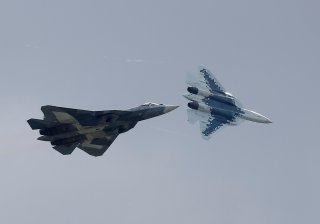It’s a Sell-Off: America’s F-35 Versus Russia’s Su-57
Who else could get the Su-57?
Here’s What You Need to Remember: While India has not ruled out purchasing the Su-57 in its unaltered form in the future, the current Indian government appears to want more fourth-generation jets from western countries. This has become a priority after the dogfight over Pakistan, in which India’s upgraded 3rd generation MiG-21 failed to shoot down a Pakistani F-16 in a close dogfight.
Fifth-generation fighter aircraft are incredibly expensive to develop. While the United States and China have proven that they can foot the cost of developing fifth-generation fighters alone, Russia appears to be trying to defray the cost of its latest fifth-generation fighter via joint development ventures and foreign sales. Sales efforts have intensified in 2019 since Rostec requested permission to export the Su-57E export variant of the fighter in March 2019. Since that request, Russia has even offered Su-57s to Turkey, a NATO nation.
But who else could get the Su-57? Who else is interested? Could this result in a “sell-off” between the F-35 and Su-57 in other nations?
Russia’s first and most serious partner in Su-57 development was India, prior to its withdrawal from the contract in April 2018. The Indian Air Force (IAF), which has a history of buying Soviet and then Russian aircraft, planned to procure a version of the Su-57 under a program called Fifth Generation Fighter Aircraft, or FGFA. However, after an evaluation of the T-50 prototype, the IAF wanted significant changes to the aircraft, which would have increased its share of the project cost.
While India has not ruled out purchasing the Su-57 in its unaltered form in the future, the current Indian government appears to want more fourth-generation jets from western countries. This has become a priority after the dogfight over Pakistan, in which India’s upgraded 3rd generation MiG-21 failed to shoot down a Pakistani F-16 in a close dogfight.
While Indian sales may be off the table for now, Russia’s export version is squarely aimed at the Asian and Middle Eastern markets. An Izvestia.ru article from February 2018 names the UAE, Egypt, and Algeria as likely export customers. Egypt’s near-term acquisition of the Su-57E seems unlikely following its purchase of over twenty Su-35S jets in March 2019.
If Egypt did buy the Su-57, it would be the eighth type of fighter they would operate, joining the Mirage 5, Mirage 2000, F-16, MiG-29M, MiG-29M2 (or MiG-35 in some marketing), Rafale, and Su-35S. Such an acquisition would place an intense logistical strain on the Egyptian air force.
Algeria is a more likely customer of the Su-57E. Currently, the Algerian Air Force operates Su-30MKAs and Su-35s. Algeria has long been a buyer of the latest Soviet and Russian military aircraft, they are notable for being one of the only foreign users of the original Mi-24A “Hind” attack helicopters.
They also have been willing to buy less popular, more experimental Russian exports like the BMPT. Algeria will probably be the first foreign operator of the Su-57 due to its close relationship with Russia and its willingness to be an early adopter of the latest Russian tech.
Conversely, the UAE has traditionally bought American and European aircraft but has recently flirted with the idea of buying Sukhoi aircraft. In 2017, a purchase of a squadron’s worth of Su-35s was said to be “imminent”, but never ended up materializing. Currently, the government is planning a purchase of fifth-generation fighters, which could come down to a competitive process between the Su-57 and F-35.
In the Asian region, the biggest possible customer is China. However, China is not likely to buy the Su-57E in great numbers, as their domestic fifth-generation fighter jet, the J-20, has already been produced in greater numbers than the Su-57E. Su-57Es delivered to China will probably just be for the purpose of reverse-engineering and evaluation, without real operational use.
However, Malaysia may be a more viable customer in Southeast Asia. In March 2019, the Su-57 was demonstrated to the prime minister of Malaysia. Malaysia currently operated the Su-30MKM alongside the F/A-18 Hornet. As one of their regional neighbors, Singapore, has announced its intention to purchase F-35s, Malaysia might fast track the procurement of its own fifth-generation stealth jets.
Charlie Gao studied political and computer science at Grinnell College and is a frequent commentator on defense and national-security issues.
This article is being republished due to reader interest.
Image: Reuters.

